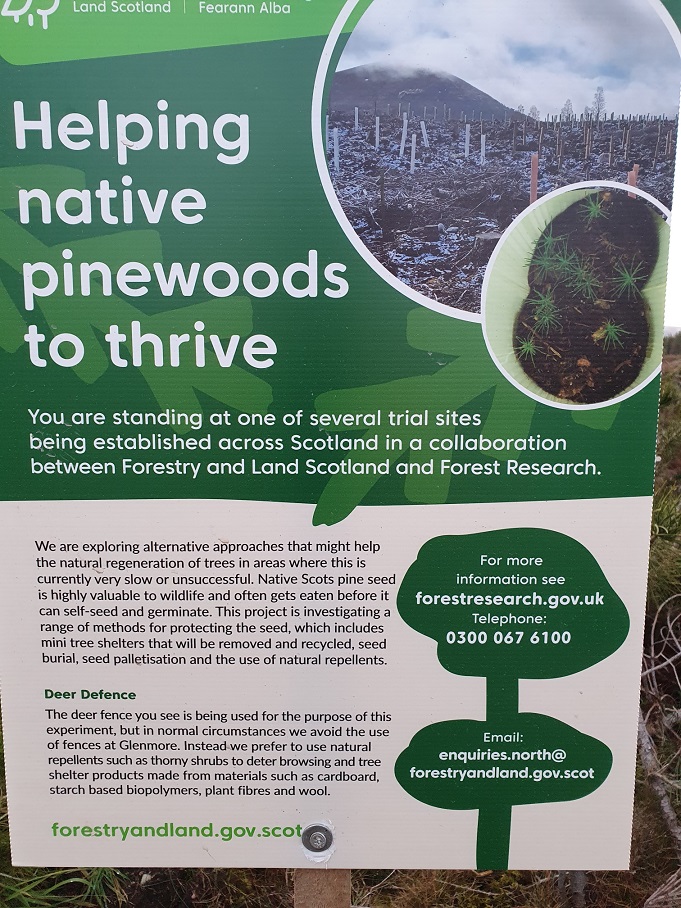
The approach that Forestry and Land Scotland (FLS) is taking to native woodland restoration at Ben Avon in the Trossachs based on natural regeneration, which I considered in my last post (see here), provides a stark contrast with how they are managing their land in the McAlpine plantation by Loch Morlich which I first considered a year ago (see here).

In the McAlpine plantation FLS have been planting trees in straight lines and in tree tubes, some of which have been “protected” by new deer fencing. It turns out (see first photo) that this is an experiment that FLS are conducting in partnership with Forest Research, an organisation which covers the whole of the UK. It is hard to imagine a more inappropriate place for such an experiment than at the heart of what should be the largest area of Caledonian forest in Scotland.
Glenmore Forest and the Strathspey Land Management Plan
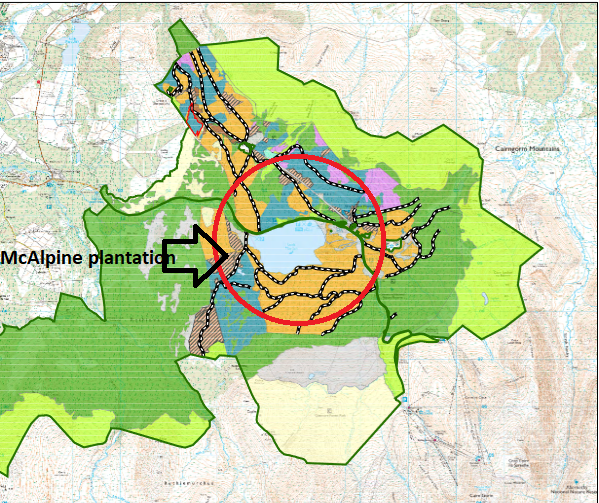
It is difficult to make sense of FLS’s plans for the Glenmore Forest from the Strathspey Land Management Plan (see here) which was approved in June 2022. Among the 24 maps accompanying the plan are concept maps, thinning maps, management zone maps, approved felling coupe maps, approved restocking maps and future habitats and species maps. The plethora of maps helps conceal the key flaw in the plan which I have illustrated on the map above.
There is a near continuous ring (dark green) of Caledonian Forest around Loch Morlich and beyond this a zone (light green) where FLS plans that the native pinewood will be allowed to expand outwards through natural regeneration. Inside the ring of Caledonian Forest is a large area which the Forestry Commission planted in the past with trees that they are now removing creating a hole.
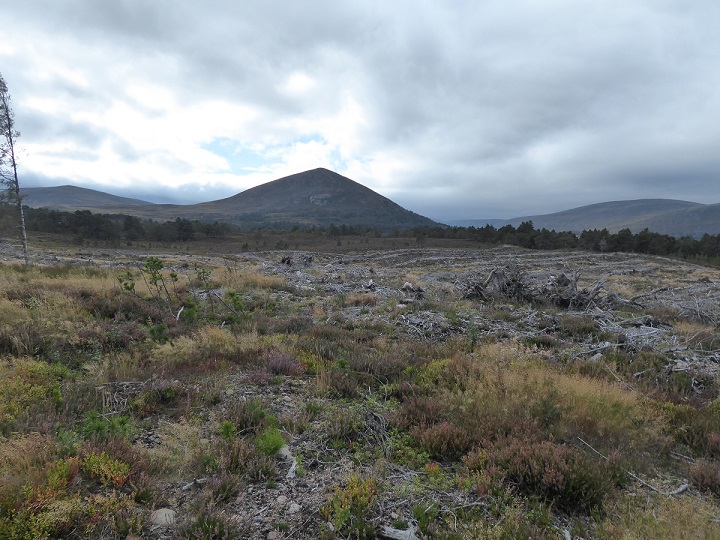
The flaw in the plan, which was approved by the regulator Scottish Forestry, is that instead of enabling this hole to close gradually through natural regeneration, it allows FLS to interfere in the process and plant certain areas:
“Restocking will be mostly via natural regeneration which will be encouraged with scarification. Direct seeding of Scots pine and native broadleaves will be undertaken in trial sites. If successful, this will be applied on other clearfell sites.”
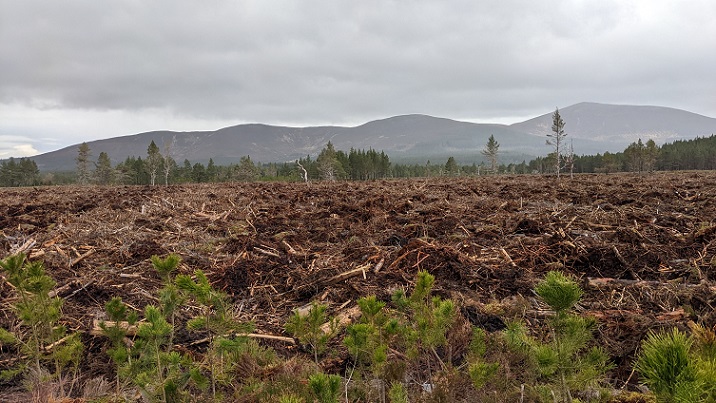
The Land Management Plan (LMP) also failed to say was that a plan for these seed planting trials, which involved 15 experimental plots, had been signed off three years previously in June 2020 and was already well underway (see here for a copy). That Experiment Plan was contrary to the ethos of natural regeneration and re-wilding and also contrary to some of the policies and management prescriptions adopted in the LMP.
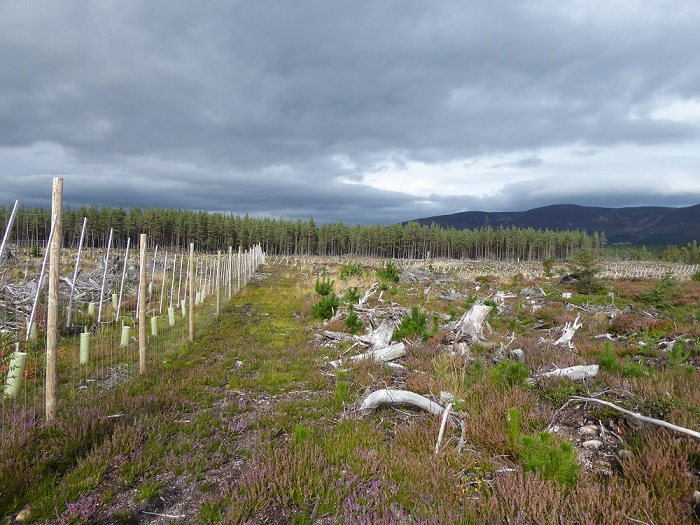
Of the 15 experimental plots, 12 are within deer fencing. The LMP’s assessment was that deer fencing in the Glenmore part of the Strathspey Forest would have “medium/high sensitivity” and stated that none was envisaged. The Experiment Plan observed that fencing “may not be possible on a large scale due to the presence of Capercaillie” but Forest Research and FLS went ahead anyway, despite the fact that capercaillie are once again facing extinction in Scotland and Glenmore is at the heart of the surviving population.

Collisions with deer fencing are probably the single greatest source of premature mortality in capercaillie. Females, which are known to disperse up to 11km from their birth areas once fully fledged, would appear to be particularly at risk from fences erected in open areas between pine woods. While Forest Research and FLS have used batons which have been shown to reduce collisions, unless placed close together capercaillie will still see the space in-between as gaps which they can fly through. The behaviour of those responsible for erecting these fences appears to me just as reckless as the birders who in their wish to see capercaillie risk disturbing them at their leks.

The Experiment Plan involved not just fencing but the use of: weedkiller, slug pellets and fertiliser:
a) Weedkiller
“Select site, and mark out treatments on site (SOP0006 v.2, SOP0048 v.2). Sub plots must be laid out so that they each contain the same number of sowing spots. Kill any established vegetation with an overall application of glyphosate (e.g. as 5 l/ha Roundup ProActive, 360 g/l glyphosate) in early September 2020.”
b) Slug Pellets
“Aluminium ammonium sulphate animal repellent, is no longer available, so those treatments using repellents (S5, S6, S11), sheep fat (Trico) will be used instead. As this is a more experimental compound for this use, and we have no information on phytotoxicity to seed or efficacy in reducing seed predation, it will be used in a more restricted number of treatments than would be the case if aluminium ammonium sulphate were available”
c) Fertliser
“For treatments using seed burial (S3 – S7, S9 – S12, S14 and S15), immediately after sowing cover the Scots pine seed with John Innes Number 1 peat / compost potting mixture to a depth of 2 cm and if possible lightly tamp down (a deeper covering may kill the seeds, but less will not help to prevent predation)”.
The underlined bits are my emphasis. Was there no-one in FLS or Forest Research concerned about testing a new chemical to see if it is toxic to pine seed in the heart of the Caledonian Pine forest? Did none of the managers involved consider there was any contradiction between restoring peat bog on the one hand (as set out in the LMP) and using a peat based compost on the other?
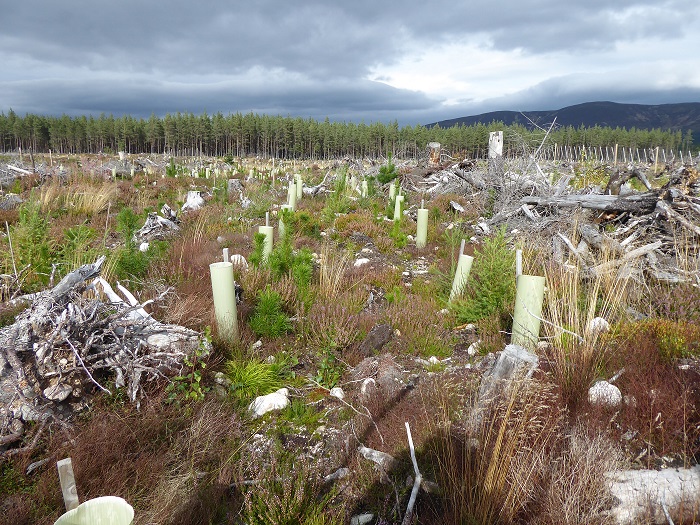
What I have not yet found out is how far the proposals set out in the Experiment Plan were applied in practice. If they were, the attempt to destroy other vegetation appears to have failed completely. The seeds in the soil that have naturally regenerated have being doing far better than those planted in tree tubes. As usual, a signficant proportion of the tubes contained no saplings.

The tree tubes in the experiment have been set out in evenly spaced rows. If the experiment is even partially successful what FLS will have created is another bog standard plantation, the opposite of a natural pinewood which it claims it wants to see in 200 years.
How too this fits with FLS’ proposals elsewhere in the LMP to restructure existing plantations in Glenmore to make them more natural is anyone’s guess.
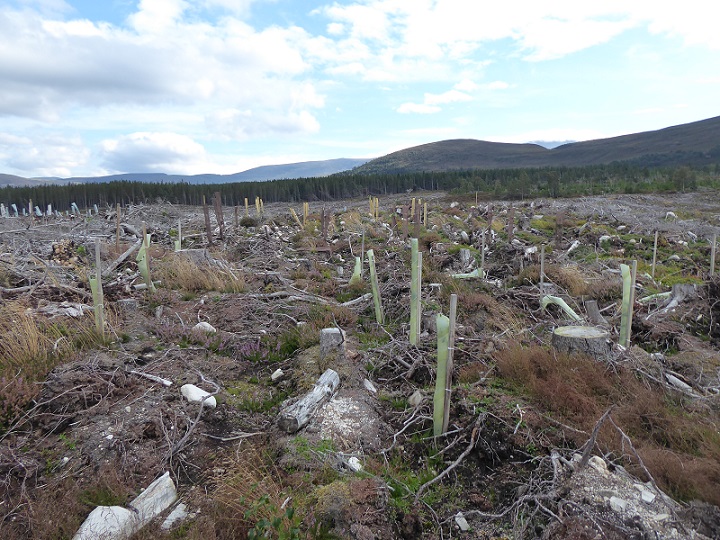
On my first visit to the McAlpine plantation last year, I had limited time and did not realise there had been further planting beyond the enclosure (a map showing all the trial areas would be a useful addition to the LMP). FLS, which has now committed to stop using plastic tree tubes, appears to using the unfenced experimental plots to test out different types of shelter.

There is something wonderful about the way that nature defies the intentions of silviculturalists and takes a different course.

The experimenters could do worse and remove these shelters before they kill the trees they are meant to be protecting.

In my view the only positive thing to be said about this experiment is there is no better place in Scotland to see for yourself the failings of tree shelters and why they are not necessary. That does not mean they should be allowed to remain in place – go while you can!
The justification for the experiment
The background section of the Experiment Plan gave a brief justification of what was proposed:
“Significant areas of native pinewoods on the national forest estate managed by Forestry and Land Scotland are not currently regenerating adequately though natural processes. In addition, extensive areas of clear felling have been taking place to remove non-native species (particularly Dothistroma infected lodgepole pine) and provide for the expansion of native pinewoods. Currently, native Scots pine is proving largely resistant to the Dothistroma it has been naturally exposed to. However, concerns over the risk of introducing new strains of Dothistroma that could potentially hybridise and overcome otherwise resistant trees mean that it is not currently possible to plant trees that have been grown in off-site nurseries on these restock sites.”
Hence the desire to experiment with the planting of pine seeds rather than pine saplings.
So keen, however, were the foresters to plant trees that they did not even stop to consider why natural regeneration of the native pinewoods on the Forest Estate might not be going that well. The answer, for the Forest Estate on Strathspey at least, is given in the LMP which commits to maintaining deer densities at the levels recorded in 2019:
As a result of what is happening in the native pinewoods at Mar Lodge and Glen Feshie, we now know that for natural regeneration to take off deer need to be reduced to two per square kilometre. FLS is not far from achieving that at Rothiemurchus and Inshriach but miles from doing so at Glenmore.
The LMP attempts to excuse these hopeless targets claiming that deer culling is difficult when numbers of visitors are so high. In doing so it failed to ask how the National Trust for Scotland has managed to reduce the deer at Mar Lodge which is also thronged by visitors. Wildland Ltd could provide FLS with the answer: use infrared telescopes, which will pick up humans as well as deer, and shoot at night.
Had FLS and Forest Research, however, bothered to wait to see what happened after the lodgepole pine had been removed from the McAlpine plantation, they would have realised that whatever the deer numbers, currently there is no problem with natural regeneration in this part of the hole in the forest.

There was therefore absolutely no justification for setting up this experiment in this location.
The real problem is not the lack of natural regeneration but rather the contrary: the non-native lodgepole pine, whose seed has lying all over the site, has a head start over the other species and is doing so well that unless action is taken soon it is likely to shade them out. What FLS needs to do therefore is act like they have at Ben A’An, weed out the lodgepole pine and keep doing so until its seed is exhausted.

That process would be easiest and cheapest when the saplings are very young, when they could simply be uprooted, but the dangers of not acting fast are illustrated by this lodgepole sign at the side of the track. – yet more non-native seed in the making!
The LMP does contain a commitment to remove non-native regeneration:
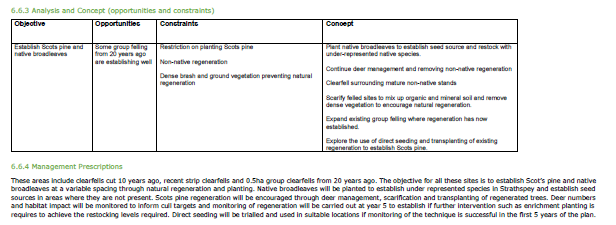
Unfortunately, to date, FLS appears to have been more interested in progressing the seed planting experiment than in fulfilling its commitment to remove non-native regeneration.
On my second and third visits to the McAlpine plantation last year, with Dave Morris, we had very helpful discussions both with the FLS staff overseeing the felling of the lodgepole pine and the contractors doing the work, including how they have “saved” the native trees surviving among the lodgepole. FLS, however, is so compartmentalised that those responsible for felling operations had no idea what the plans were to remove the non-native regeneration as this was not within their remit.
What needs to happen
Appendix 13 to the LMP lists the responses to the consultation on the plan and records that at a meeting of Cairngorms Connect, of which FLS is a member, “Wildlands (sic) requested that wording around natural regeneration was discussed to show a coordinated approach”. How prescient that was as, by their actions at the McAlpine plantation, both FLS and Forest Research threaten all the good work that been to done to establish that the best way to restore Scotland’s native pinewoods is through natural regeneration.
FLS now needs to do three things in Glenmore:
- Abandon the experiment in the McAlpine plantation and remove the deer fencing and tree shelters as soon as possible.
- Set up a programme to weed out non-native trees as their seeds regenerate. This would best be done by employing a permanent forester/s who were based locally but with a little bit of imagination volunteers could also make a contribution. In my view it might be much better to use volunteers to get rid of non-native species rather than using them, as RSPB has done, to plant trees in remote places like the Loch Avon basin.
- Reduce deer numbers in Strathspey to two per square kilometre.

I think that something that is often forgotten is that Glenmore is a National Forest Park declared at the time of the old Forestry Commission and still is. Within these parks it is declared, “At all these Forest Parks, attention is given to the conservation of natural resources of all kinds. Good land utilisation is practised and throughout the area wildlife is protected. Careful regard is paid to amenities and scenic effects both in arrangement of plantations and the design and siting of buildings.” The experiments described by Nick seem to me, from my own experience of such work, to confuse a study into how to achieve a good dense timber stand with that for encouraging natural regen in a native pinewood. Incidentally, when the upper half of the Forest Park was handed over to the HIDB, it was done under a few charter that stated the area would continue to be part of the Glenmore Forest Park. Well Well. I don’t find what Nick has observed fits terribly well with that policy statement, in particular when you consider the very high recreational and tourism value of Glenmore. I am also puzzled that the only emphasis is on the welfare of Scots Pine. Glenmore – at Ryvoan, has one of the only two significant populations of wild holly in the Eastern Highlands (the other being in Birse). There used to be another much smaller but significant on the SW side of Loch Muick but at last inspection that had largely gone – grazing pressures I think.
Minor point but the use of night/thermal sights for shooting deer is illegal in Scotland. There was a review of deer law a couple of years ago which recommended allowing them but no laws have been changed yet.
Tim, thanks, its an important point and I apologise for the error. I should have remembered this because Wild Land Ltd, and its important to stress this, were using night sights to see where the deer were, not to shoot them. I understand they did use lights for a time, like grouse shooting estates do to shoot hares, but the deer learned about this so it stopped being successful. Given infra red sights however are now so good as a result of technological development, I think there is good reason to amend the law and make it legal to use them at night within prescribed rules. That would help estates cull deer through the winter when they often move down to the lower and more accessible ground after dark.
It’s clear from the evidence presented that this Experimental Plan has been (and always going to be) a failure. Is there any acknowledgement from FLS on this, or are the people responsible for this experiment just determined to keep going? Some response from FLS would be valuable, even to determine whether or not FLS has seen the error of its ways.
Your constant moaning you do not say how you would do better other that you want more deer shot its easy to see you know nothing about deer culling with sugestions of using illegal methods I would suggest you get some real lufe experience of the subject you moan about and may be make suggestions based on experience
Sometimes the solution is right in front of us. Reducing deer to a level that allows regeneration while at the same time carefully monitoring it – removes the need for these human engineered solutions with all the faults they contain. FLS has a responsibility to the public when it decides to play with the crown jewels.
Also, the Scottish Government cannot abdicate responsibility here. If FLS cannot manage to stay betweens it lines, decision making oversight with a different remit should be setup. Normally that could be Cairngorms National Park authority, but they seem to have similar problems of either non-enforcement, or approving schemes that go against their charter